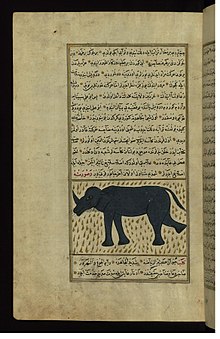Karkadann
A fragment of Al-Biruni preserved in the work of another author adds a few more characteristics: "the horn is conical, bent back towards the head, and longer than a span...the animal's ears protrude on both sides like those of a donkey, and...its upper lip forms into a finger-shape, like the protrusion on the end of an elephant's trunk."
[3] After Al-Biruni, Persian scholars took his description and formed ever more fanciful versions of the beast, aided by the absence of first-hand knowledge and the difficulty of reading and interpreting old Arabic script.
He lists a few beneficial effects: holding the horn opens up the bowels to relieve constipation, and it can cure epilepsy and lameness.
[2] In the 14th century, Ibn Battuta, in his travelogue, calls the rhinoceros he saw in India a karkadann, and describes it as a ferocious beast, driving away from its territory animals as big as the elephant;[5] this is the legend that is told in One Thousand and One Nights in the "Second Voyage of Sinbad the Sailor".
[9] Al-Qazwini, one of the earliest authors to claim the horn is an antidote to poison, also notes that it is used in the manufacturing of knife handles.
According to Chris Lavers, The Natural History of Unicorns, khutu, a somewhat enigmatic material possibly consisting of ivory or bone, had been ascribed alexipharmic properties.
[13] The initial portion of Persian kargadan resembles the Sanskrit word "khaRga" for rhinoceros also meaning sword, where "R" represents a retroflex flap sound.
